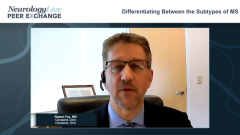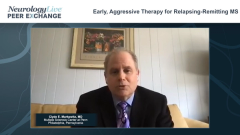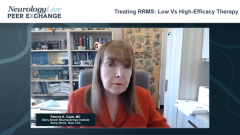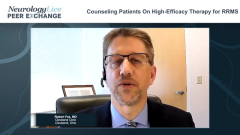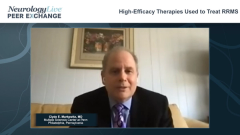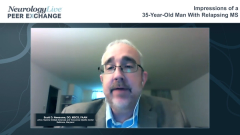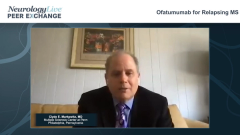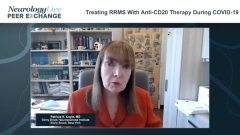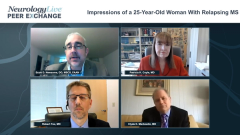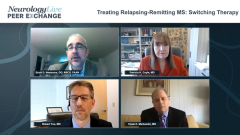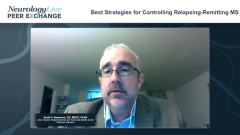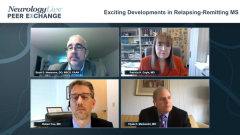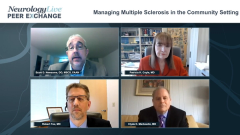
Treating Relapsing-Remitting MS: Switching Therapy
Factors that may warrant a switch in therapy to treat relapsing-remitting multiple sclerosis.
Episodes in this series

Scott D. Newsome, DO, MSCS, FAAN: Clyde, what about in your clinic the Multiple Sclerosis Center at Penn? What are the factors you take into consideration for switching therapies? We always ask about adherence, obviously. I remember early in my career—now that I am apparently midcareer, which makes me feel older—there was a patient who I had asked whether they were taking their medication, and they said, “Yes, I am taking my medication.” I then came to find out that they were taking it but not as prescribed. They did not lie to me; they were taking it but not as prescribed. I have now changed my wording a bit. In someone who is adherent, what are the factors that come into play in your clinic that make you say, “Maybe we need to switch?”
Clyde E. Markowitz, MD: Remember that I never need to switch because I put people on the highest efficacy compounds from the beginning. I will just put that out there.
Compliance is important, so we monitor people closely. I get a scan at 3 months from whatever drug they started on, so I have a new baseline from that point going forward. If the patient comes in at their 3-month visit and tells me that they have been having some adverse effect issues or having struggles with whatever the treatment is, whether it be GI [gastrointestinal] adverse effects, or maybe we did some bloodwork and there are concerns on some of the blood tests, or tolerability issues, then we have a conversation about trying to figure out how to manage that. It could be a laboratory abnormality, it could be a mechanism of switching, it could be a tolerability issue, and it could be an efficacy issue depending upon what compound they are on. These are all important pieces.
I am amazed that, even in today’s world, people come into my office and say, “You know what, doctor? I have to come clean with you. I told you that I was taking this medication, but I really was not taking it.” Even though they are telling me that they were taking the medication, some may have been flat out lying to me to my face about what they were taking. That exists to some degree as well, and the way we would ideally be able to figure that out is if we had some sort of pharmacy tracking for whether they are getting their refills when they need to. Occasionally, you will even have people who dump it down the toilet and not tell you. We will put that aside for a moment.
Those are the main factors: tolerability, laboratory abnormalities, and efficacy would be the biggest factors. The efficacy could be clinical, so when they come in for their visits every 3 months, I am initially doing a full neurologic examination to determine if there are things going on of which they may be unaware or about which they are in denial. We then do an MRI scan. In the first year, I am doing a follow-up MRI scan 6 months after their last scan. If they got a 3-month scan, then I am doing another scan 6 months after that because I want to capture any disease activity early. Knowing that the 3-month scan is their new baseline, I now want to see how they do over the next 6 months and if there is any disease activity, such as new T2 lesions or new Gd [gadolinium]-enhancing lesions.
I might make a switch at that point. I am not necessarily going to wait around, but it also depends on what compounds they are on and what the potential options are. If somebody is…antibody positive, I may not be thinking that I am going to be able to put them on natalizumab as another go-to therapy. If they were on natalizumab and are in that conversation, then I have other options to consider at that point. We look for what we feel is the best control of disease activity. I use MRI frequently for trying to gauge those points at least early on because I am trying to predict if somebody is going to be a good responder, and we then make adjustments as needed.
Scott D. Newsome, DO, MSCS, FAAN: For me, the more I do this, the lower the threshold is that I have to switch. It is for those patients who start on the more modest therapies because I agree to some extent that the higher efficacy drugs do a fantastic job of suppressing new inflammatory activity whether it is relapse-based or imaging-based.
As we enter into the world of biomarkers, such as NfL [neurofilament light chain] and GFAP [glial fibrillary acidic protein], and as we use some of the more sophisticated imaging techniques, maybe we will come back and do another webinar like this and say, “We thought we were doing a great job, but we actually were not. We need even more high-efficacy drugs than what we have, and that is where bone marrow transplant will come into play.”
Clyde E. Markowitz, MD: Let’s get real now. That is right.
Scott D. Newsome, DO, MSCS, FAAN: That’s right.
Thank you for watching this NeurologyLive® Peer Exchange. If you enjoyed the content, which I hope you did, please subscribe to our e-newsletters to receive up-and-coming Peer Exchanges and other great content right in your inbox.
Transcript Edited for Clarity
Newsletter
Keep your finger on the pulse of neurology—subscribe to NeurologyLive for expert interviews, new data, and breakthrough treatment updates.


